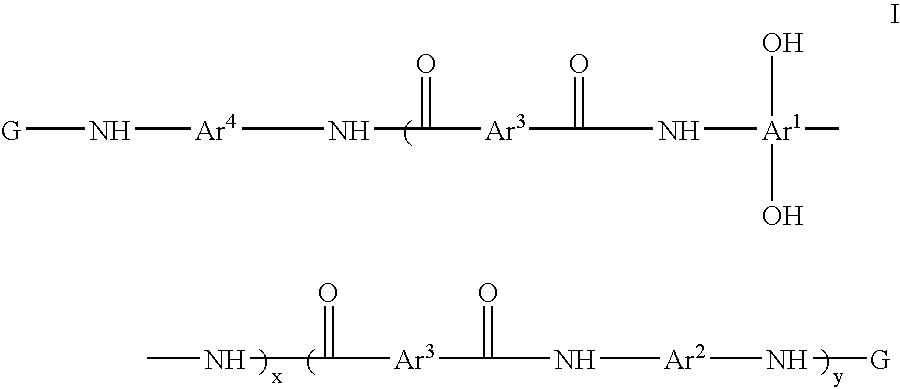Photosensitive resin compositions
a technology of resin compositions and resins, applied in the field of negative photosensitive resin compositions, can solve the problems of low contrast, low contrast, and a bit of dark erosion
- Summary
- Abstract
- Description
- Claims
- Application Information
AI Technical Summary
Benefits of technology
Problems solved by technology
Method used
Image
Examples
synthesis example 1
Preparation of PBO Precursor with Amino End Groups (V)
[0076]
[0077]To a 2 L, three-necked, round bottom flask equipped with a mechanical stirrer, nitrogen inlet and addition funnel, 155.9 g (426.0 mmol) of hexafluoro-2,2-bis(3-amino-4-hydroxyphenyl)propane, 64.3 g (794.9 mmol) of pyridine, and 637.5 g of N-methylpyrrolidone (NMP) were added. The solution was stirred at room temperature until all solids dissolved and then cooled in an ice water bath at 0-5° C. To this solution, 39.3 g (194 mmol) of isophthalyl chloride, and 56.9 g (194 mmol) of 1,4-oxydibenzoyl chloride dissolved in 427.5 g of NMP, were added drop-wise. After the addition was completed, the resulting mixture was stirred at room temperature for 18 hours. The viscous solution was precipitated in 10 liters of vigorously stirred de-ionized water. The polymer was collected by filtration and washed with de-ionized water and a water / methanol (50 / 50) mixture. The polymer was dried under vacuum conditions at 105° C. for 24 hou...
synthesis example 2
Synthesis of Polymer of Structure V with Alternative Monomer Ratio
[0079]To a 100 mL three-necked round bottom flask equipped with a mechanical stirrer, nitrogen inlet and addition funnel, 3.66 g (10 mmol) of hexafluoro-2,2-bis(3-amino-4-hydroxyphenyl)propane, 1.70 g (21 mmol) of pyridine and 15 g of N-methyl-2-pyrrolidone (NMP) were added. The solution was stirred at room temperature until all solids dissolved and then cooled in an ice water bath at 0-5° C. To this solution, 1.01 g (5 mmol) of isophthaloyl chloride and 1.477 g (5 mmol) of 1,4-oxydibenzoyl chloride dissolved in 10 g of NMP was added drop-wise. After the addition was completed, the resulting mixture was stirred at room temperature for 18 hours. The viscous solution was precipitated in 800 mL of vigorously stirred de-ionized water. The polymer was collected by filtration and washed with de-ionized water and a water / methanol (50 / 50) mixture. The polymer was dried under vacuum at 105° C. for 24 hours. The yield was almos...
synthetic example 3
Preparation of a PBO Precursor with Acetyl End Groups (Ia)
[0080]
[0081]The PBO precursor obtained in Example 1 (100 g) was dissolved in 1000 g of Diglyme. Residual water was removed as an azeotrope with Diglyme using a rotary evaporator at 65° C. (10-12 torr). About 500 g of solvents was removed during the azeotropic distillation. The reaction solution was placed under a N2 blanket, equipped with a magnetic stirrer and cooled using an ice bath down to about 5° C. Acetyl chloride (3.3 ml, 3.6 g) was added via syringe. The reaction was held on the ice bath for about 10 min. Then the ice bath was removed and the reaction was allowed to warm up over the period of 1 hr. Then, the mixture was again cooled to about 5° C. on the ice bath. Pyridine (3.7 ml, 3.6 g) was added via syringe over the period of 1 hr. The reaction was kept on the ice bath for about 10 min, and then was allowed to warm up over the period of 1 hr. The reaction mixture was then precipitated into 6 L of water with stirri...
PUM
| Property | Measurement | Unit |
|---|---|---|
| Electrical resistance | aaaaa | aaaaa |
| Adhesion strength | aaaaa | aaaaa |
Abstract
Description
Claims
Application Information
 Login to View More
Login to View More - R&D
- Intellectual Property
- Life Sciences
- Materials
- Tech Scout
- Unparalleled Data Quality
- Higher Quality Content
- 60% Fewer Hallucinations
Browse by: Latest US Patents, China's latest patents, Technical Efficacy Thesaurus, Application Domain, Technology Topic, Popular Technical Reports.
© 2025 PatSnap. All rights reserved.Legal|Privacy policy|Modern Slavery Act Transparency Statement|Sitemap|About US| Contact US: help@patsnap.com



